Case Study
User Experience of Collaborative Interaction in Low Earth Orbit
This project focused on improving collaborative interactions between astronauts in Low Earth Orbit (LEO), on the International Space Station (ISS). The goal was to identify design requirements that could enhance teamwork in space, considering the unique challenges posed by the environment, such as restricted physical movement, communication limitations, and constrained workspaces.
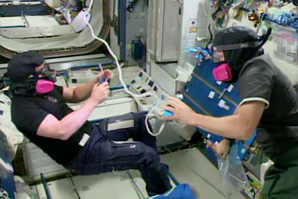
Photo: NASA TV/Spaceflight Now
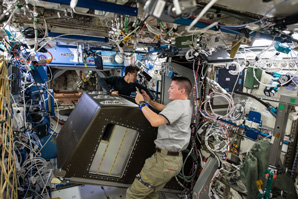
Photo: NASA
STAR Summary
To provide a concise snapshot of the process and outcomes, the following STAR (Situation, Task, Action, Result) model summary outlines the key elements of this case study:
Situation: On the ISS, collaborative work is crucial to mission success, yet current workspaces and tools are not optimized for effective teamwork. With limited communication tools, restricted movement, and insufficient workspace configurations, astronauts often face challenges when working together in LEO.
Task: I was tasked with researching the challenges of collaborative work in space and identifying design requirements to improve team interactions. This required a deep understanding of both the physical constraints (using MIL-STD-1472) and the cognitive demands (via NASA’s Human Systems Integration guidelines) of collaborative tasks in space.
Action: Using a combination of literature reviews, stakeholder interviews, census analysis, and video footage analysis of team activities on the ISS, I explored the mechanics of collaborative work in LEO. This allowed me to measure and model team activity, identifying opportunities for improvement in workspace design, communication tools, and collaborative training.
- MIL-STD-1472: I used this standard to analyze the physical and ergonomic needs of astronauts performing close-proximity tasks. This involved identifying acceptable reach envelopes, spatial configurations, and task allocation for optimal teamwork.
- NASA Human Systems Integration Process: I applied this process to ensure the design recommendations were aligned with NASA's human factors standards for space missions. I conducted stakeholder interviews, analyzed procedural documents, and examined video footage of collaborative astronaut work to assess the effectiveness of current systems.
- Team Anthropometry Modeling: I created models of astronauts’ reach envelopes using Siemens’ JACK human factors simulation software to visualize and measure overlapping work areas during collaborative tasks.
Result: My research identified several key design requirements to improve astronaut collaboration in space. These included:
- Improved communication tools that accounted for delays and barriers in space.
- Flexible workspace configurations that allowed astronauts to reconfigure their environment for different tasks.
- Enhanced training to better prepare astronauts for collaborative tasks in LEO.
These findings provided actionable recommendations that NASA could incorporate into future habitat and vehicle designs to improve team collaboration and performance in space.
Human Factors Standards:
During this project, I applied MIL-STD-1472, which outlines human engineering design criteria, to assess the usability and human interaction aspects of astronaut activities. Additionally, I leveraged the NASA Human Systems Integration process to evaluate collaborative work environments and team tasks, ensuring that design recommendations were grounded in established human factors principles.
Research Methods:
I used a combination of literature reviews, stakeholder interviews, census analysis, and video analysis of astronaut work. I analyzed team activity from 2014 on the ISS, including tasks such as Leak Pinpoint and Repair, Large Object Relocation, and System Assembly and Installation.
Measuring Overlapping Reach Envelopes in Collaborative Tasks
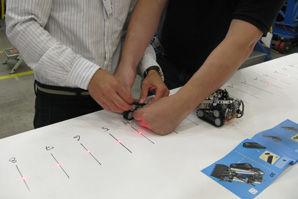
Photo: Anthony Carton
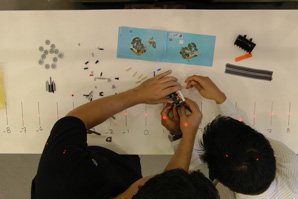
Photo: Anthony Carton
These images capture two participants performing a generic team activity, where I used MIL-STD-1472 guidelines to assess the ergonomic reach envelopes. The red dots projected from the testing stand (which I designed) allow us to precisely measure the areas of overlap between the participants’ reach. This analysis is critical in understanding how physical proximity and restricted movement in Low Earth Orbit (LEO) affect team collaboration. The insights from this study informed recommendations for optimizing workspace configurations aboard the ISS to improve task performance and reduce physical strain during collaborative activities.
Tracking Collaborative Reach Using Motion Capture Technology

Photo: Anthony Carton
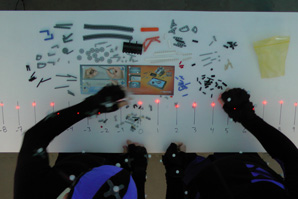
Photo: Anthony Carton
In these images, I worked with technicians to employ motion-capture suits to analyze team dynamics and assess collaborative reach in accordance with MIL-STD-1472 standards. This was the first time the Human Factors team at MSFC had captured data from multiple participants simultaneously. The red light dots visible on the participants’ wrists allow us to track precise reach movements, providing valuable insights into how astronauts will interact in confined workspaces. This analysis was instrumental in developing recommendations for optimizing physical collaboration and reducing the potential for ergonomic issues aboard the ISS.
Modeling Collaborative Reach Using Human Factors Simulation
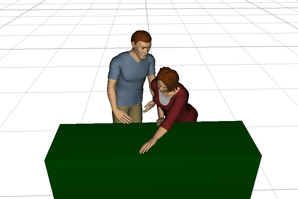
Photo: NASA

Photo: NASA
These images show the 3D modeling of overlapping reach envelopes for two participants, created using Siemens' JACK human factors simulation software. By applying MIL-STD-1472 standards, I was able to analyze how team members interact within constrained environments. As I developed team activity classes, these models allowed me to create distributions for each activity type, providing detailed insights into how astronauts can optimize physical collaboration in Low Earth Orbit (LEO). This data was crucial in generating ergonomic design recommendations to enhance task efficiency and reduce strain during collaborative missions aboard the ISS.
Team Activity Classes for Collaborative Work in Space
Through my research and analysis of collaborative tasks aboard the International Space Station (ISS), I identified distinct team activity classes that characterize how astronauts perform tasks together in Low Earth Orbit (LEO). Using a combination of task analysis, video footage review, and Human Factors simulation software (such as Siemens’ JACK), I developed a classification system to group these activities based on their physical and cognitive demands.
Team Activity Classes were defined by key factors such as:
- Spatial interaction: The extent to which team members’ reach envelopes overlap, influencing how efficiently they can work together in confined environments.
- Task complexity: The degree of coordination required, including whether tasks are independent, sequential, or simultaneous.
- Physical proximity: The level of physical closeness required, factoring in the unique challenges of zero gravity and constrained workspace.
- Communication needs: The necessity for verbal or non-verbal cues to complete the task, accounting for potential communication barriers in space.
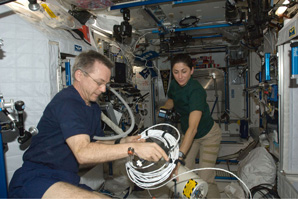
Photo: NASA
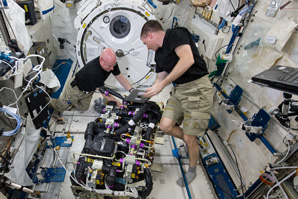
Photo: NASA

Photo: NASA
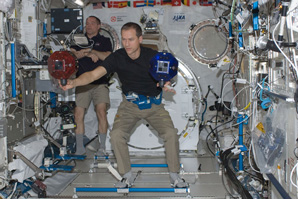
Photo: NASA
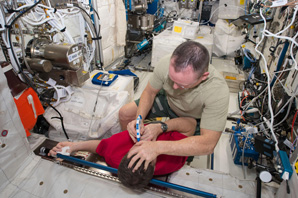
Photo: NASA
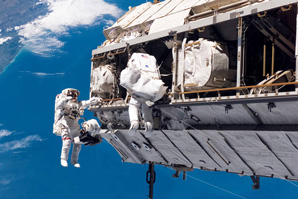
Photo: NASA

Photo: NASA
Classifying Team Tasks
Overlapping Reach and Coordination: Many team tasks in space require overlapping physical spaces, creating ergonomic challenges that could lead to inefficiencies or physical strain. By classifying activities based on these overlaps, I was able to propose design improvements for workspace configurations and astronaut equipment.
Communication-Intensive Activities: Tasks that required high levels of real-time communication, such as equipment assembly or joint inspections, were often hindered by delayed or unclear communication tools. My classification system helped highlight these critical tasks and inform recommendations for better communication technologies.
Task-Specific Training Needs: The classification also revealed that certain team activities, particularly those involving complex coordination, would benefit from enhanced training. This insight informed recommendations for collaborative task training, which could prepare astronauts more effectively for team-based operations in space.
This system of team activity classes provided a structured way to analyze astronaut collaboration, enabling NASA to make targeted improvements in workspace design, communication tools, and training programs to support more efficient and safer team activities in space.
Findings:
Based on the literature review, stakeholder interviews, and video analysis, I identified several key findings related to the challenges and opportunities for improving collaborative work in Low Earth Orbit (LEO):
- Low Levels of Collaborative Activity: My analysis revealed a significant opportunity for increasing collaborative interactions on the International Space Station (ISS). While collaboration is essential to mission success, the current level of collaborative work is relatively low. The constraints imposed by the environment—such as limited workspace and physical reach—reduce the opportunities for astronauts to work effectively as a team.
- Challenges of Collaborative Work in LEO: Several challenges hinder collaborative work in space. Communication difficulties are exacerbated by delays and barriers inherent to the space environment. Additionally, physical limitations, such as restricted movement due to the confined workspace, and overlapping reach envelopes (analyzed using MIL-STD-1472) present ergonomic and logistical challenges for astronauts working in close proximity.
- Design Requirements for Improvement: My study identified critical design requirements that could enhance team collaboration in LEO, grounded in NASA’s Human Systems Integration process and MIL-STD-1472 standards. These include:
- Improved communication tools that are designed to mitigate delays and facilitate real-time interaction between team members.
- Flexible workspace configurations that can be easily adjusted for different tasks and allow astronauts to maximize their ergonomic reach and workspace utilization.
- Enhanced training and support for collaborative work, ensuring that astronauts are well-prepared to perform complex team tasks under the physical and cognitive demands of space missions.
These findings provide a solid foundation for improving both the physical and communication systems aboard the ISS, ultimately enhancing the effectiveness and efficiency of collaborative tasks in Low Earth Orbit.
Conclusion and Recommendations
This project provided valuable insights into the nature of collaborative work in Low Earth Orbit (LEO), specifically aboard the International Space Station (ISS). Through a combination of task analysis, team activity classification, and video analysis, we identified significant opportunities to improve astronaut collaboration, particularly in addressing physical, communication, and ergonomic challenges.
Key Recommendations:
- Improve Communication Tools: Given the importance of real-time coordination during team tasks, especially for communication-intensive activities, it is critical that NASA invests in more reliable and intuitive communication technologies that can overcome the unique barriers of space environments, such as signal delays or communication interruptions.
- Flexible Workspace Configurations: The findings from the overlapping reach envelope analysis emphasize the need for more adaptable workspaces that allow astronauts to configure their environments based on the specific tasks at hand. Designing flexible, modular workspaces would reduce physical strain and enhance task efficiency.
- Enhanced Training for Collaborative Tasks: As some team activities involve high levels of complexity and coordination, astronauts would benefit from more focused training on team-based operations. Incorporating task-specific training based on the classifications of collaborative activities can better prepare crews for effective teamwork in confined, zero-gravity environments.
These recommendations not only address the ergonomic and logistical challenges faced by astronauts but also provide a roadmap for improving team performance and safety on future space missions. By incorporating these design requirements into the next generation of space habitats and training protocols, NASA can significantly enhance collaborative work in LEO, contributing to the overall success of future missions.